Cultivating positive qualities and responsibility for learning through Reading across the Curriculum
Background
Ta Ku Ling Ling Ying Public School accords high priority to character-building and self-directed learning so as to foster students' whole-person development. Apart from addressing the school concerns, teachers were aware of the need to enhance students' reading exposure. Hence, they designed a Reading across the Curriculum (RaC) programme to develop positive values among students and promote self-directed learning. Through the RaC programme, students not only broadened their reading exposure and knowledge base, but also learnt to care for the nature and be more responsible for their own learning.
Level(s)
P4-5
Strategies used
The following strategies were adopted in the RaC programme:
Integration of self-directed learning elements into the task design
In order to improve students' self-directed learning habits and capabilities, writing rubrics were adopted in all RaC modules to help students set learning goals and monitor and evaluate their learning progress. Word lists were also used for students to expand their vocabulary bank in their own time.Adoption of life-wide learning and experiential learning
Authentic contexts related to students' daily life were set in the RaC modules for boosting their interests in learning and promoting care for animals, plants and the environment. Life-wide learning and experiential learning activities related to these contexts were designed to give students opportunities to learn by themselves and use English meaningfully outside the classroom.Effective use of resources
Different types of resources were used to facilitate the smooth preparation and running of the RaC programme:Resource types
Purposes
Natural resources, for example, plants, insects and animals, found inside and outside the school
- To cultivate a sense of belonging to the school and the community and promote care and love among students
Financial resources
- Grant Scheme on Promoting Effective English Language Learning
- Subsidies from charities
- Life-wide Learning Grant
- To create space for teachers to design the RaC modules
- To improve Internet connection (e.g. buying portable Wi-Fi devices) for students who live in remote areas to learn outside school and maximise their learning time
- To buy activity materials (e.g. herbs) and support them to do experiential learning activities at home
What happened
Mapping the curriculum of the English Language and General Studies subjects
English Language teachers had curriculum mapping with General Studies teachers to select appropriate themes for the RaC modules. For example, there is a unit about plants in the P4 General Studies syllabus. In the P4 English Language curriculum, comparatives and superlatives are covered. English Language teachers decided to plan a module regarding the plants at school for students to learn more about plants and compare plants using the target language. Apart from mapping relevant themes, the subject-specific knowledge was always covered by content subject teachers before the implementation of the RaC modules.
The table below summarises the focuses of the P4 and P5 RaC modules implemented in the English lessons:-
Learning and teaching in action
- P4 RaC module: "Plants and Flowers"Steps
Learning activities
Key features*
Step 1:
Revisiting content subject knowledge- Read a fiction text called "The Giving Tree" to provide the context for learning different parts of a tree
- Read a non-fiction text called "Seed to Plant" to revisit subject-specific knowledge – different parts of plants and how plants grow
- Did an extended self-directed learning task on labelling different parts of flowers
Revisiting "germination"
Step 2:
Learning vocabulary/reading skills- Read a non-fiction text called "Spring Plant" to learn about word formation and summarising skills

Learning about suffixes
Step 3:
Getting to know the plants at school- Studied four plants at school in detail
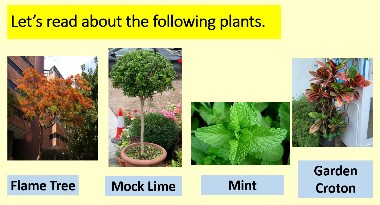
Learning more about four plants at school
Promoting care for the plants at school
Step 4:
Learning about measurements- English teachers sought advice from a Mathematics teacher on appropriate use of subject-specific vocabulary (e.g. circumference)
- Learnt how to use rulers or measurement tapes to measure plants
- Learnt to use "centimetre(s)" or "metre(s)" to describe the length or width of plants using "It is… centimetres/metres long/wide."
- Learnt adjectives to describe the physical appearance of the plants (e.g. round, hairy, pointy)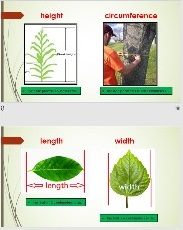
Learning how to measure plants with different tools
Step 5:
Taking part in a life-wide learning activity- Took part in a garden tour at school to closely study and measure the plants by themselves
- English Language teachers adapted the learning and teaching materials and shared a garden tour PowerPoint, fact sheets and findings collected by students during the online classes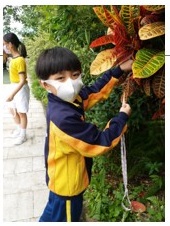

Up-close contact with nature
- Promoting care for the plants at school
- Adopting life-wide learning to enable students to learn by themselves and use English meaningfully outside the classroomStep 6:
Writing 1 (A fact sheet about the plants at school)- Revisited the target language – comparatives and superlatives
- Analysed the findings collected during the garden tour
- Set learning goals in the domains of content, language and organisation with the help of rubrics
- Improved self-monitoring and self-evaluation skills using the rubrics while and after writing a fact sheet about the four plants at school
Analysing findings recorded during the garden tour for writing a fact sheet
Improving students' self-directed learning habits and capabilities of goal setting, self-monitoring and self-evaluation
Step 7:
Writing 2 ("My Favourite Plant at School")- Learnt to give reasons with "because" and adjectives (e.g. beautiful)
- Played a word puzzle based on adjectives in a word bank
- Set learning goals in the domains of content, language and organisation with the help of rubrics
- Improved self-monitoring and self-evaluation skills using the rubrics while and after writing "My Favourite Plant"
Using adjectives to give reasons
Improving students' self-directed learning habits and capabilities of goal setting, self-monitoring and self-evaluation
- P5 RaC module: "The Herb Garden"
Steps
Learning activities
Key features*
Step 1:
Learning reading skills- Read a fiction text called "Stregna Nona" to learn prediction skills and how to identify the main idea
- Read the "Ling Ying Herb Garden Fact Sheets" to learn about features of fact sheets and how to locate specific information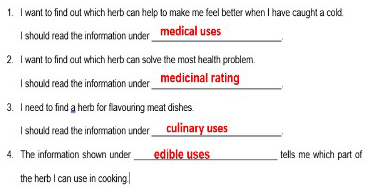
Learning how to locate information in a fact sheet
Step 2:
Self-directed learning of vocabulary- Expanded a vocabulary list called "My Cooking Word Mat" while and after reading the fiction and non-fiction texts in the module
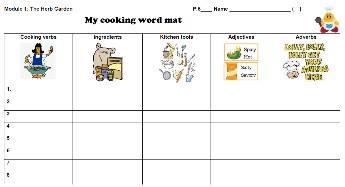
"My Cooking Word Mat"
Improving students' self-directed learning habits and capabilities of expanding the vocabulary bank in their own time
Step 3:
Acquiring content subject knowledge- Read a non-fiction text called "The Yummy Alphabet Book" to learn about herbs and their uses
- Read the Ling Ying Herb Garden Fact Sheets and learnt to appreciate how herbs could help them
- Learnt about how herbs are used in different cuisines, paving the way for the final writing task
Use of herbs in different cuisines
Showing appreciation for what herbs can give us
Step 4:
Doing text comparison- Compared a good recipe and a bad recipe and learnt the importance of using appropriate language items to make their recipes more reader-friendly

Analysing a good recipe
Step 5:
Writing (A recipe with herbs as ingredients)- Learnt about recipe features
- Read recipes of different levels of complexity to broaden students' exposure to different presentation styles
- Recapped imperatives and action verbs for writing a recipe
- Set learning goals in the domains of content, language and organisation with the help of rubrics
- Improved self-monitoring and self-evaluation skills with the rubrics while and after writing the recipe

Reading recipes of different levels of complexity
Improving students' self-directed learning habits and capabilities of goal setting, self-monitoring and self-evaluation
Step 6:
Doing an experiential learning activity- Chose a favourite herb and talked about what to cook with the herb
- Did an experiential learning activity at home with parents' support
- Bought the ingredients
- Made the dish by following the instructions in the recipe they had written
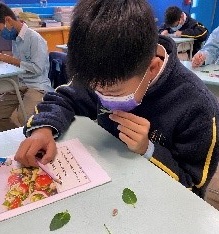
Touching and sniffing the herbs

Cooking a dish with herbs at home
Adopting experiential learning to enable students to learn by themselves and use English meaningfully outside the classroom
*Key features related to positive values and attitudes, self-directed learning, life-wide learning and experiential learning
Levels |
Modules |
Contexts |
Infusion of positive personal qualities |
||
School environment |
Community |
Natural environment |
|||
P4 |
"Plants and Flowers" |
Plants at school |
Care for plants and flowers |
||
P4 |
"Insects" |
Insects at school |
Care for insects |
||
P4 |
"Animal Riddles" |
Animals at school |
Animals near school |
Care for animals |
|
P5 |
"The Herb Garden" |
Herbs at school |
Appreciation for what herbs can give us |
||
P5 |
"The Bio-water Garden" |
Water at school |
Water, water problems and how to save water |
Responsibility for the environment |
|
P5 |
"The Butterfly Garden" |
Butterflies at school |
Care for butterflies |
||

Selecting the themes and learning materials carefully for cultivating
a sense of belonging and care for living things among students
Impact
Curriculum level
The school English Language curriculum was more holistically planned:
There was meaningful integration of values education, self-directed learning and life-wide learning into the learning and teaching process to help students achieve whole-person development.
By mapping learning elements of the General Studies subject into the English subject, students were supported to make connection between the two subjects, hence breaking the knowledge boundary.
There was more progression in learning. For instance, the module on water was covered at P5 instead of P4 because the content subject knowledge involved is more complex and cognitively challenging.
Student level
From students' reflections and interviews, the following can be observed:Broadened exposure and knowledge about nature: Students enhanced their knowledge of using different herbs in cooking and learnt more about the plants, insects and animals inside and outside school. They were also able to apply such knowledge in their writing.

A sample of student writing – “My Favourite Plant at School”
Nurtured positive personal qualities: Students showed more care for living things at school and around them. They realised they should not hurt animals and insects. They were also more aware of the responsibility they have for the environment.

Students’ self-reflections
Improved self-directed learning capabilities: With the help of rubrics, students set higher but achievable learning goals in the domains of content, language and organisation before writing. They worked towards their goals by monitoring their own learning while writing and doing self-evaluation after writing using the same set of rubrics.
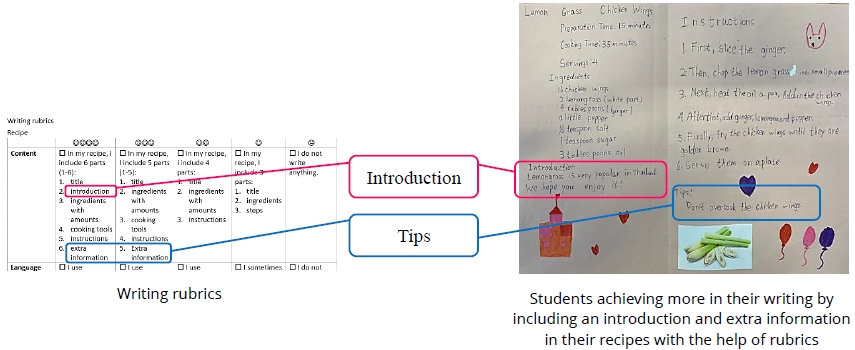
Conclusion
Teachers of this school conceptualised their experiences and found the following facilitating factors essential to the planning and implementation of their RaC programme:
Collaboration with content subject teachers
Curriculum mapping among different Key Learning Areas was significant for making learning coherent. By identifying commonalities between English Language and General Studies, it gave teachers a clear direction for selecting appropriate themes and reading materials for the RaC modules. It also helped their students make connections with their learning across subjects.Parental support
Parents' help was solicited in the learning process. Parents supported their children's learning by buying herbs and cooking with them. In the module on "The Bio-water Garden", students interviewed their family about how to save water at home, giving them ideas for their writing. Without parental support, the RaC programme would not have been implemented so smoothly and effectively.
Bibliography
Curriculum Development Council. (2014). Basic Education Curriculum Guide – To Sustain, Deepen and Focus on Learning to Learn (Primary 1 - 6). Hong Kong: Author.
Knowles, M.S. (1975). Self-directed learning: A guide for learners and teachers. New York: Association Press.
Task Force on Review of School Curriculum. (2020). Optimise the curriculum for the future, Foster whole-person development and diverse talents. Hong Kong: Author.
Ta Ku Ling Ling Ying Public School
Florence YIP (Language Support Officer)